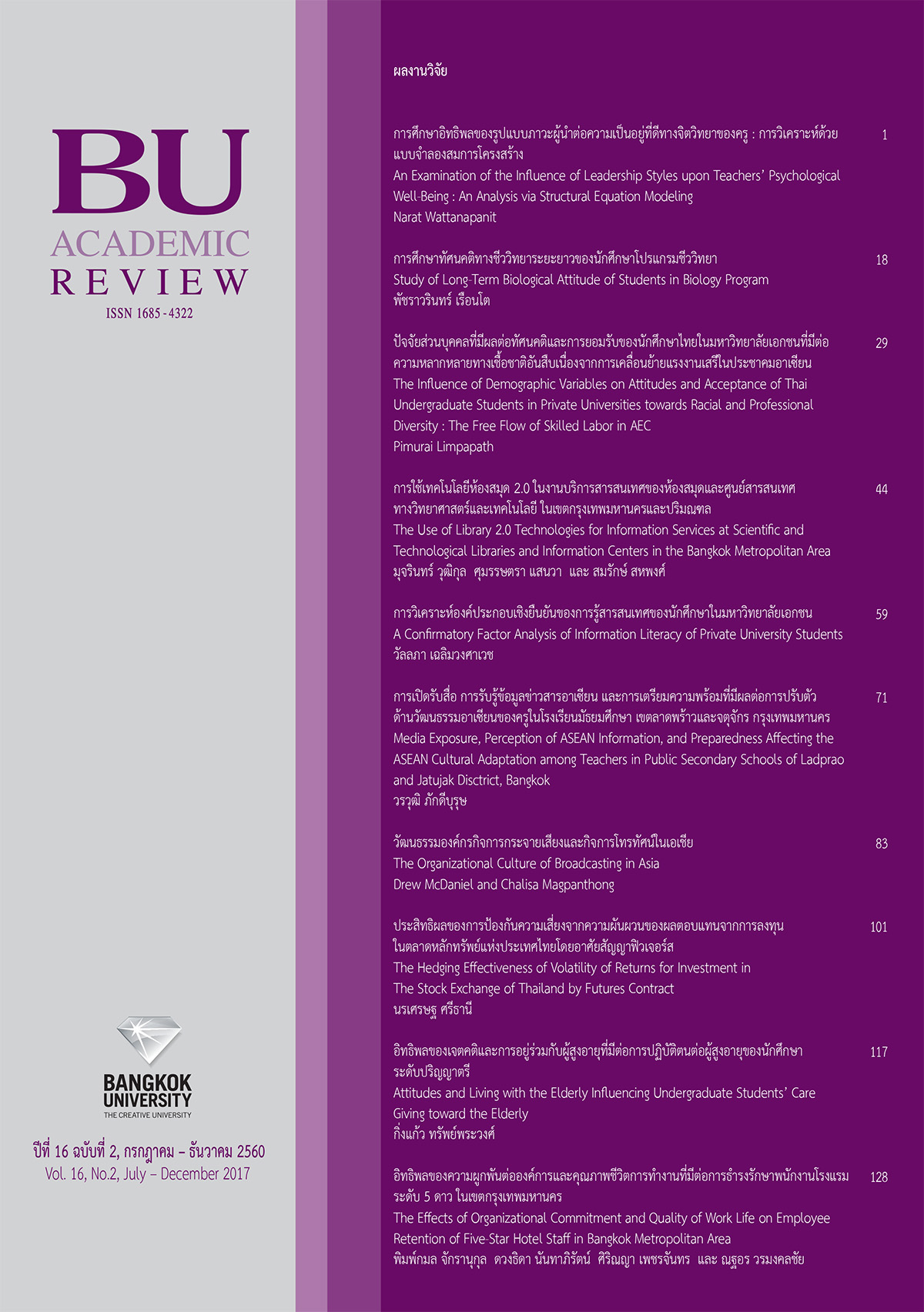ประสิทธิผลของการป้องกันความเสี่ยงจากความผันผวนของผลตอบแทนจากการลงทุนในตลาดหลักทรัพย์แห่งประเทศไทยโดยอาศัยสัญญาฟิวเจอร์ส
Main Article Content
Abstract
การศึกษาครั้งนี้มีวัตถุประสงค์เพื่อเปรียบเทียบรูปแบบการประมาณค่าอัตราส่วนของการป้องกันความเสี่ยงโดยใช้ SET50Index Futures เป็นเครื่องมือช่วยป้องกันความเสี่ยง ในแบบจำลองต่างๆ ที่มีประสิทธิภาพสูงสุด โดยใช้ข้อมูลราคาปิดรายวันของ SET50Index Futures และหลักทรัพย์จำนวน 260 หลักทรัพย์ ในช่วงเดือน พฤษภาคม 2555 ถึงเดือน กุมภาพันธ์ 2556 โดยเริ่มจากการประมาณค่าอัตราส่วนป้องกันความเสี่ยงที่เหมาะสมทั้งรูปแบบจำลองคงที่ (static model) ได้แก่ แบบจำลองกำลังสองน้อยที่สุด (Ordinary Least Squares (OLS)) ตัวแบบเวคเตอร์อัตสหสัมพันธ์ (Vector Autoregressive Model (VAR)) และแบบจำลองเวกเตอร์การปรับตัวสู่ดุลยภาพระยะยาว (Vector Error Correction Model (VECM)) และแบบจำลองเคลื่อนไหว (dynamic model) ได้แก่ แบบจำลองวัดความผันผวนแบบมีเงื่อนไข (Generalized Autoregressive Conditional Heteroscedasticity Model (GARCH)) เพื่อเปรียบเทียบประสิทธิผลของการป้องกันความเสี่ยงของแบบจำลองดังกล่าว ผลการศึกษาพบว่าแบบจำลองที่ให้ค่าอัตราส่วนป้องกันความเสี่ยง (optimal hedge ratio) ที่มีประสิทธิผลสูงสุดที่สามารถลดความผันผวนของอัตราผลตอบแทนของหลักทรัพย์ได้มากที่สุด คือแบบจำลอง DVEC-GARCH (1,1) ซึ่งเป็นแบบจำลองประเภทพลวัต (dynamic) โดยค่าอัตราป้องกันความเสี่ยงที่ได้จากแบบจำลองนี้มีการเปลี่ยนแปลงไปตลอดเวลา ซึ่งสอดคล้องกับอัตราผลตอบแทนของหลักทรัพย์ที่มีการเปลี่ยนแปลงไป ในขณะที่ค่าอัตราส่วนป้องกันความเสี่ยงที่ได้จากแบบจำลองประเภทคงที่ (static) ทุกแบบจำลอง ให้ผลลัพธ์ที่ด้อยกว่า เนื่องจากค่าอัตราส่วนป้องกันความเสี่ยงที่ได้เป็นค่าคงที่ตลอดเวลาไม่ว่าอัตราผลตอบแทนของหลักทรัพย์จะเปลี่ยนแปลง นอกจากนี้ยังขึ้นอยู่กับระดับความสัมพันธ์ของอัตราผลตอบแทนของหลักทรัพย์และอัตราผลตอบแทนของ SET50Index Futures
This study aims to find and compare the hedging effectiveness by using index futures contract from the Stock Exchange of Thailand (SET). Two hundreds and sixty sample securities from SET were selected to study and its daily closing price was collected to compute the returns of those stocks from May 2012 to late February 2013. Models for estimation optimal hedge ratio come from both static models and dynamic model. The static models include, for example, Ordinary Least Squares (OLS), Vector Autoregressive Model (VAR), and Vector Error Correction Model (VECM), while the dynamic model includes Generalized Autoregressive Conditional Heteroscedasticity Model (GARCH). The empirical results showed that the hedging effectiveness of optimal hedge ratios from the dynamic model, especially the estimation from the DVEC-GARCH (1,1), outperformed all static models because the dynamic models could change over time in accordance with the returns of stock. Nevertheless, the result of hedging effectiveness from static models showed inferior solution because its optimal hedge ratio did not change while the returns vary over time. Moreover, the effectiveness of optimal hedge ratio was considered in relation with the strength of relationship between the returns of those stocks and SET50Index Futures.
Article Details
The manuscript submitted for publication must be the original version, submitted only to this particular journal with no prior acceptance for publication elsewhere in other academic journals. The manuscript must also not violate the copyright issue by means of plagiarism.


